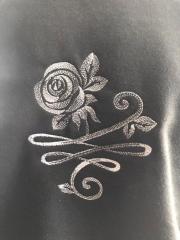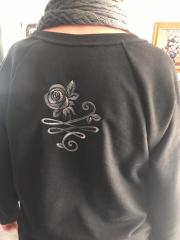Search the Community
Showing results for tags 'METALLIC'.
-
Steel rose free embroidery design
ekatreina posted a gallery image in Elevate Your Creations with Flowers embroidery designs
This picture is fragment of back side of stylish woman’s sweater. It is dark clothing made of practical knitwear. But Marilyn Maurer Palumbo creates original solution to make this thing original and unique. It is Steel rose free embroidery design chosen for its decoration. Its color scheme it absolutely suitable for main color of this work piece. It is pretty detail which completes your look. -
There is a wide range of thread choices available to todayís embroiderer. However, unless time is taken to experiment with different choices, they may never get a chance to offer them to their customer. Most new embroiderers purchase a start up kit with their equipment that contains one type of thread. They start with and continue to use this same thread as if it is the only style available, without ever considering if there is a better alternative. As it turns out, there are several types and styles of thread and the professional embroiderer needs to be aware of their characteristics and applications. Commercial embroidery threads are most commonly grouped by fiber content as follows: rayon, polyester, metallic and cotton. Within each fiber group, threads are available in different thicknesses or weights. Weight is an important consideration, as it can affect the visual quality of a design. A 40 weight is considered the standard for the industry. A higher number is thinner, while a lower number is thicker. Most designs are digitized with a 40 weight thread in mind. For example, a large area designed to be filled with stitches created using 40 weight thread would appear nice and solid upon completion. If the embroiderer switched to 60 weight thread, which is not as thick, then the ìfilledî area would have many gaps. One trick for reducing thread counts is to use a heavier thread such as 35 weight. Because it is thicker, fewer stitches are needed to cover the same area than if a 40 weight thread were being used. RAYON Rayon thread has been the mainstay of the commercial embroidery industry for many years. It is soft, brilliant and durable. Rayon is available in a wider range of colors, than any other thread. It can withstand dry cleaning and multiple washings. However, some colors do not resist bleach very well. A 40 weight is considered the standard for rayon. Several manufacturers offer it in other weights such as 60, 35, 30 and 12. A 60 weight rayon is ideal for creating smaller detail work. To be successful, it should only be used with a smaller needle such as a 60 or 65. When using a heavier weight thread such as 30 or 35, a larger needle will be required. POLYESTER Polyester thread has gained popularity in the last few years and is fast overtaking rayon as the thread of choice amongst commercial embroiderers. Though not available in as many colors as rayon, there is still a wide range of choices, with more being added every year by the manufacturers. Polyester thread is considered more durable than rayon and can withstand the harsh effects of bleaching. This makes it the ideal choice for garments that will undergo frequent washings, such as service uniforms that are worn in ìdirtyî environments. Like rayon, the standard weight for polyester is 40. Some manufacturers offer it in 30 weight as well. Because polyester is slightly stiffer than rayon, fine design details may need to be digitized differently when using it. Another characteristic of polyester thread is that it is more elastic than rayon. Thus, some stretching followed by rebounding can occur while sewing. The result is tiny loops forming on top of the embroidery design. Therefore, the thread tensions should be increased (on the machine) to control this problem. METALLIC Metallic thread is a specialty thread that is used to create unique textures and special effects. Their construction is very unique and they come in three different variations: core-wrapped, twisted and flat-foil. All of them have some sort of foil used in their construction. These foils are generally metalized polyester. Core-wrapped is the most common and gives the smoothest, most even shine. It is created by wrapping the foil around a core yarn of rayon, polyester or nylon, resulting in a round thread with a metallic covering. Metallic threads can be difficult to use. They are less flexible than rayon or polyester and do not flow easily. In fact, there is a tendency for them to ìkinkî while sewing which leads to thread breaks and ìbird nests.î Thus, when sewing with metallic thread, slower machine speeds are required along with the undivided attention of the machine operator. Once again, 40 weight is the most common size. However, even though it is approximately the same thickness as a 40 weight rayon, the density of an area sewn with metallic should be programmed five to ten percent less than if rayon were being used. I recommend a large eye needle when using metallic threads. COTTON Rayon and polyester threads are known for their high luster finishes. Cotton on the other-hand has a low luster, almost dull finish. This can be quite useful for creating different looks. It is available in many weights, with 40 being the standard, but a limited number of colors. It withstands repeated washings very well, but not bleaching. Cotton is an excellent choice for sewing designs with high detail. It is also very useful for creating designs where the desire is for a low key, understated appearance. There are many thread choices available to the embroiderer. Chances are you will use 40 weight rayon or polyester for the majority of your work. But take some time to experiment and see what you can create using different weights and styles. THREAD STORAGE Thread should be stored in a cool, dark location. Manufacturers suggest a humidity level of 40% to 60% and a temperature ranging between 50 and 70 degrees Fahrenheit. Direct sunlight is also not good for thread, as it can cause discoloration over time. Threads should also be kept covered to prevent dust and lint buildup, which will cause the thread to soften. This leads to thread breaks. Thread is one of those things that we depend heavily on, but typically ignore until it causes a crisis, such as excessive thread breaks and/or shreds. Such problems may be the result of a defective cone, but it is far more likely that the quality issues are the result of improper handling and storage. The most important aspect of thread care is proper storage. Most embroiderers use the same system for managing their thread inventory ñ all over the place. Walk in to almost any shop and you will see various cones piled up in every available location ñ counter tops, shelves, desks, the back of a machine, etc. This is the worst possible way to handle your valuable thread as it can lead to the following situations: Thread Dents ñ (What the heck is that?) When a cone falls onto the floor, the point of impact can ìdentî the thread, resulting in a weak spot (or spots) that can ultimately lead to problems as the thread travels towards the needle. If you are one of those people who sees the machine as the idle storage location for unused cones, then you are at high risk for causing thread dents, as those cones will ìwalkî across the machine table due to the vibration of sewing and ultimately end up on the floor. Discoloring & Fading ñ Threads, especially rayon, will fade when exposed to sunlight for extended periods of time. If your threads are stored on a window sill or anywhere that sunlight can strike them full force, you risk fading and discoloring. Lint Build-up ñ If your thread is sitting out, exposed to the elements of your shopís environment, chances are that dust and lint are building up on it at a rapid clip. Over time, such buildup can sink down into the threads. When the thread travels through the upper thread path, it takes the crud with it, dispensing it along the way onto critical surfaces (such as tensioners) that need to remain clean and smooth. The result will be inconsistent upper thread tension and possible thread breaks. Brittleness ñ In addition to discoloring and fading, excessive exposure to sunlight can dry out the thread and lead to brittleness in the fibers. Obviously, this will weaken the thread and lead to excessive thread breaks. So now that you know the results of improper thread storage, it is time to focus on how to prevent such problems. The key is to store your threads the right way each and every day. The best storage system is one that keeps the threads in a secure location, out of sunlight and free from dust and lint. In addition, it should be a cool environment. If you are a small shop with only a hundred cones of thread or so, then a large plastic container with a snap-on lid will probably work just fine. Avoid the clear-plastic models. For larger shops, running multi-head machines, thread storage becomes a bit more complex. Consider a large cabinet with shelves and pull-out bins, either plastic or cardboard. Such bins should not be mechanically connected to the shelves, such that they can be fully removed from the cabinet for easy access. Usually such bins are available in a wide range of sizes. If you have a six head machine, then you want to find bins that can hold at least six cones of thread each. This way, you can store all of one color in one bin and label it on the outside for easy reference. Such a storage system not only protects your threads, it also increases your efficiency, as all threads are stored together and labeled for quick identification. Of course, if you donít put the threads away promptly after using, then any thread storage system you invest in probably wonít help very much. You can also invest in plastic sleevs for your threads
-
Hello I would like to provide me with embroidery thread shining but not metallic, rather those with the reflections that change according to the light. Where do you provide? knowing that I am Belgian, and here it is very difficult to find this kind of material. Someone could help me find it? It's almost beautiful days and my girls wanted a flashy look for this summer. I already bought on ebay in a US seller but the quality was not good, the wire broke all the time even on small pieces and with a special needle, but it was written in Chinese (or Japanese)on packaging,so I think it revendais bad quality. I want a good quality that takes good Thank you
-
Embroidered sweater with rose design
ekatreina posted a gallery image in Elevate Your Creations with Flowers embroidery designs
This is cool woman’s sweater which is real clothing with secret. It looks quite ordinary from front side: it is oversize sweatshirt in dark color scheme. But when you look at it from back side you see one little pretty detail made by Marilyn Maurer Palumbo . It is Steel rose free embroidery design. It is stylized picture of beautiful flower executed in suitable shade. It makes this clothing stylish thing in monochrome color scheme. -
-
- jpg format
- Madeira FROSTED MATT
-
(and 1 more)
Tagged with:







